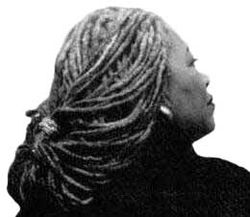Stephen Metcalf in Slate:
 In 1987, Toni Morrison's Beloved won the Pulitzer Prize. In 1992, with Beloved still widely regarded as her masterpiece, Morrison was awarded the Nobel Prize for Literature. Three legs make a stool: This past month, in a New York Times poll of 200 critics, writers, and editors, Beloved was named “the single best work of American fiction published in the last twenty-five years,” beating out novels by such luminaries as Roth, DeLillo, and Updike. I participated in this survey and can attest that, from the moment the solicitously hand-typed letter from the Times Book Review arrived in the mail, Beloved was the presumptive winner.
In 1987, Toni Morrison's Beloved won the Pulitzer Prize. In 1992, with Beloved still widely regarded as her masterpiece, Morrison was awarded the Nobel Prize for Literature. Three legs make a stool: This past month, in a New York Times poll of 200 critics, writers, and editors, Beloved was named “the single best work of American fiction published in the last twenty-five years,” beating out novels by such luminaries as Roth, DeLillo, and Updike. I participated in this survey and can attest that, from the moment the solicitously hand-typed letter from the Times Book Review arrived in the mail, Beloved was the presumptive winner.
Like two other American novels devoted to race, The Adventures of Huckleberry Finn and To Kill a Mockingbird, Beloved exists wholly beyond its own artistic merits and demerits. These books have become something more than mere literature; they're homework, with an afterlife guaranteed by their place (or in the case of Huck Finn, its embattled absence) on the high-school and college syllabus. (“Only Shakespeare rivals her in the number of senior theses devoted to her work,” Harvard English professor Barbara Johnson has said.) Were it simply a matter of social redress, we could all go home now, the Dead White Males having been forced to cocktail with a Living Black Woman. But Beloved isn't solely a work of protest and advocacy, as Morrison herself has insisted, nor solely a symbol for the progress and virtue of the prestige-granting institutions in American letters. It's a serious novel and a work of art, and it deserves to be accorded the highest respect. It deserves, in other words, to be asked, Yes, but are you any good?
For those who haven't read it, Beloved tells the story of Sethe, an ex-slave who has resettled to the outskirts of Cincinnati with her daughter, Denver. Near the beginning of the book, the two are joined by Paul D, once Sethe's fellow slave on a Kentucky plantation called “Sweet Home.” (After years of thankless yearning, Paul D has at last become Sethe's lover.) It's 1873, the Civil War has been fought, and though slavery as a legal institution is over, it has only started its haunting of the African-American psyche. This Morrison dramatizes with the actual haunting of Sethe's house by Sethe's deceased baby daughter. We never learn that baby's given name, but in exchange for sex, Sethe has had a headstone carved for her girl, bearing the single word “Beloved.” Paul D exorcises the house of the ghost, but later, upon returning from a carefree day spent at a carnival, Sethe, Denver, and Paul D discover a young woman sleeping near the front door of their house. The young woman goes by the name Beloved, and from all appearances she is a revenant, the embodied spirit of Sethe's dead daughter.
Morrison presents Sethe's turbulent inner life through a process both Morrison and Sethe herself call “rememory,” a kind of psychic haunting in which the specifics of a traumatic incident are told and retold, even as the teller tries to block their full emergence into the conscious mind. The central traumatic episode of Beloved, to which the narrative returns again and again, is an infanticide: Twenty years earlier, Sethe beheaded her baby Beloved with a handsaw rather than allow her return to slavery. In Beloved, Morrison perfected a mode of narration, entirely her own but with roots in everything from the African griot to As I Lay Dying, built out of compulsive repetition, in which the onion, as it were, is constantly being both peeled and reconstituted; in which memories are constantly being both exhumed and buried; and in which the mind of the storyteller is both imprisoned and set free in the act of retelling. And so, like the return of Beloved, and the enduring curse of slavery itself, rememory is both a reconciliation and a vexation, both a healing and a wounding.
More here. (Note: In my opinion, Beloved ranks with Moby Dick in representing the best of American fiction. This is a good month to read or re-read this brilliant work of genius. Please do it.)
Let's see, how should I spend my Sunday? Should I keep reading Herwig Wolfram's magisterial History of the Goths? Should I perhaps go a-hunting online for some whimsical new videos of cats doing unexpected things? Or should I check to see if there are any noteworthy athletic spectacles on television?
